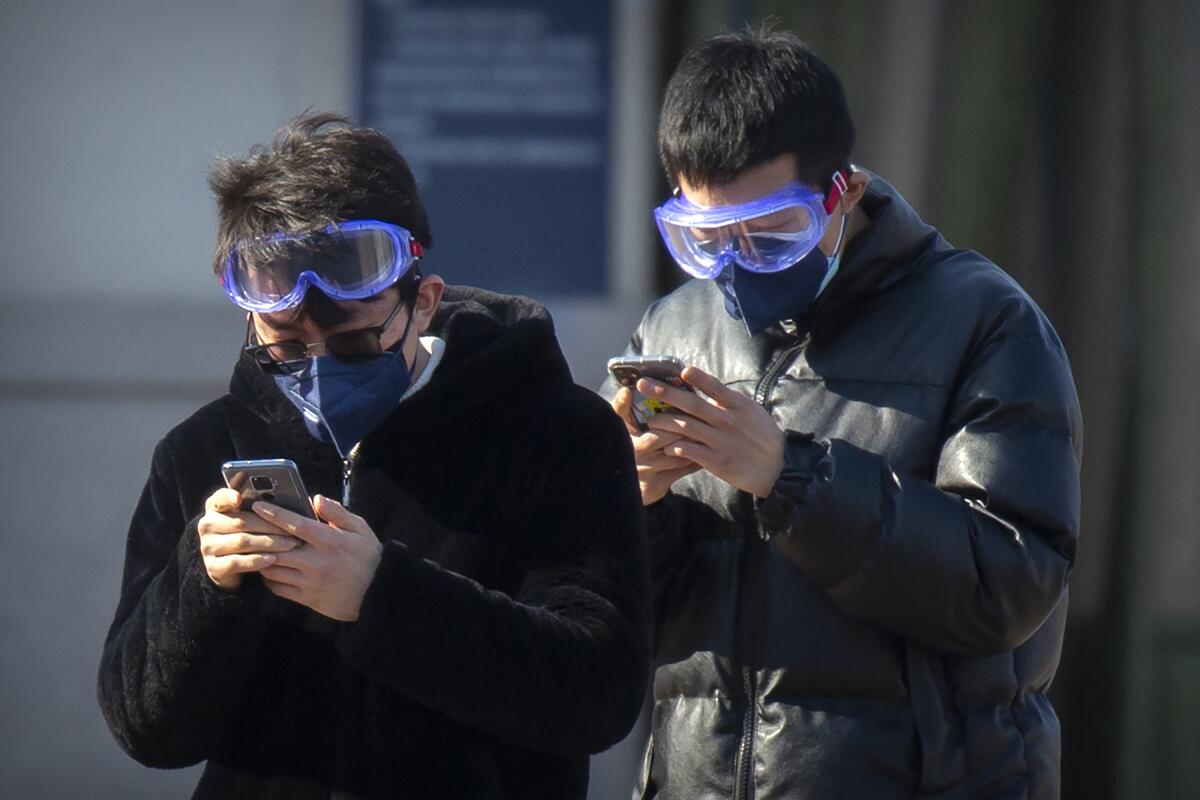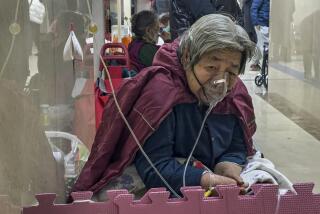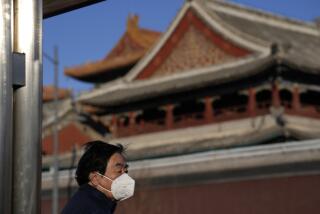Xi’s early involvement in coronavirus outbreak raises questions

- Share via
BEIJING — A recent speech by Chinese President Xi Jinping that was published by state media indicated for the first time that he was leading the response to the coronavirus outbreak from early on in the crisis.
The publication of the Feb. 3 speech was an apparent attempt to demonstrate that the Communist Party leadership had acted decisively from the beginning but also opened Xi up to criticism over why the public was not alerted sooner.
In the speech, Xi said he gave instructions on fighting the new strain of the virus Jan. 7 and ordered the shutdown that began Jan. 23 of cities at the epicenter of the outbreak. His remarks were published by state media late Saturday.
“On Jan. 22, in light of the epidemic’s rapid spread and the challenges of prevention and control, I made a clear request that Hubei province implement comprehensive and stringent controls over the outflow of people,” Xi told a meeting of the party’s standing committee, its top body.
The number of new cases in mainland China fell for a third straight day, China’s National Health Commission reported Sunday. The 2,009 new cases in the previous 24-hour period brought the total to 68,500.
Commission spokesman Mi Feng said the percentage of severe cases had dropped to 7.2% of the total from a peak of 15.9% on Jan. 27. The proportion is higher in Wuhan, the Hubei city where the outbreak started, but has fallen to 21.6% from a peak of 32.4% on Jan. 28.
“The national efforts against the epidemic have shown results,” Mi said at the commission’s daily media briefing.
Taiwan on Sunday reported its first death from the virus, the fifth fatality outside of mainland China. The island also confirmed two new cases, raising its total to 20.
Taiwan’s Central News Agency reported that the person who died was a male in his 60s living in central Taiwan. The man had no recent overseas travel history and no known contact with virus patients, CNA said, citing Minister of Health and Welfare Chen Shih-chung.
China reported 142 more deaths, almost all in Hubei, raising the mainland China death toll to 1,665. An additional 9,419 people have recovered from COVID-19, as the new coronavirus has been labeled, and have been discharged from hospitals.
The virus has spread to more than two dozen countries.
Japanese Prime Minister Shinzo Abe convened an experts meeting to discuss measures to contain the virus in his country, where one person has died and more than a dozen cases have emerged in the past few days without any obvious link to China.
“The situation surrounding this virus is changing by the minute,” Abe said.
Japanese Health Minister Katsunobu Kato said the country was “entering into a phase that is different from before,” requiring new steps to stop the virus from spreading further.
About 400 Americans on a quarantined cruise ship in Japan were awaiting charter flights home, as Japan announced an additional 70 infections had been confirmed on the Diamond Princess. Canada, Hong Kong and Italy said they were planning similar flights.
Japan now has 413 confirmed cases, including 355 from the cruise ship, and one death from the virus.
Xi’s role was muted in the early days of the epidemic, which has grown into one of the biggest political challenges of his seven-year tenure.
His disclosed speech indicated top leaders knew about the outbreak’s potential severity weeks before such dangers were made known to the public. It was not until late January that officials said the virus could spread between humans and public alarm began to rise.
Zhang Lifan, a commentator in Beijing, said it wasn’t clear why the speech was published now. One message could be that local authorities should take responsibility for having failed to take effective measures after Xi gave instructions in early January. Alternatively, it might mean that Xi, as the top leader, was willing to take responsibility because he was aware of the situation, Zhang said.
Trust in the government’s approach to outbreaks remains fractured after the SARS epidemic of 2002 and 2003, which was covered up for months.
Authorities in Hubei and Wuhan faced public fury over their initial handling of the epidemic. In an apparent response, the Communist Party’s top officials in Hubei and Wuhan were dismissed and replaced last week.
Hubei announced Sunday that all vehicle traffic would be banned across the province, expanding on an existing ban in Wuhan, in another step to try to stop the spread of the virus. Exceptions will be made for vehicles involved in epidemic prevention and transporting daily necessities.
The fall in new cases followed a spike of more than 15,000 announced Thursday, when Hubei began to include those who had been diagnosed by a doctor but not yet confirmed by laboratory tests.
The roughly 380 Americans aboard the cruise ship docked at Yokohama, near Tokyo, were given the option of taking U.S.-government chartered aircraft back to the U.S., where they would face another 14-day quarantine. Those going to the U.S. were to begin leaving the ship Sunday night. People with symptoms were to be banned from the flights.
The Japanese defense ministry said around 300 of the Americans were preparing Sunday night to leave on buses to take them to Tokyo’s Haneda Airport.
The U.S. Embassy in Tokyo said Washington was evacuating the Americans because the passengers and crew members on board the Diamond Princess were at high risk of exposure to the virus.
About 255 Canadians and 330 Hong Kong residents are on board the ship or undergoing treatment in Japanese hospitals. There are 35 Italians, of whom 25 are crew members, including the captain.
The American evacuees will be taken to Travis Air Force Base in California, with some continuing on to Lackland Air Force Base in Texas.
Malaysia said it would not allow any more passengers from another cruise ship to transit the country after an 83-year-old American woman from the MS Westerdam tested positive for the virus.
She was among 145 passengers who flew from Cambodia to Malaysia on Friday. Her husband also had symptoms but tested negative for the virus. The Westerdam was turned away from four ports around Asia before Cambodia allowed it to dock in Sihanoukville late last week.
Malaysian Deputy Prime Minister Wan Azizah Wan Ismail said that her country would bar cruise ships that came from or transited any Chinese ports from docking.
Cambodia said earlier that all 1,455 passengers on the Holland America-operated ship had tested negative for the virus.
More to Read
Sign up for Essential California
The most important California stories and recommendations in your inbox every morning.
You may occasionally receive promotional content from the Los Angeles Times.










